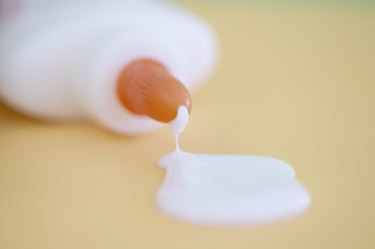
Glue is not a recent invention. Its first use dates back to the Neanderthals thousands of years ago. It became popular, however, with Egyptian, Greek and Roman artists. Egyptians would often use glue in papyrus production, while Greeks and Romans utilized glue for mosaic floors. Although today's white glue follows a different method of production, it is remarkably similar to that created and used in ancient times.
Ingredients
Video of the Day
Traditional white glue consists of unwanted animal parts usually procured from slaughterhouses. These parts include bones, tendons, feet, hides, ears and tails. Chemicals are added in the modern manufacturing process to dye the glue, clean the hides or cancel out other, unwanted chemicals.
Video of the Day
Creating the Stock
Manufacturers first wash the animal parts in an industrial-strength washer. They then remove any dirt left in the hide after the washing process. After removing the dirt, the hides are soaked in water to soften them. Lime is then added to break them down. Finally, to remove the lime, acetic or hydrochloric acid is introduced into the mixture.
Thickening the Stock
Manufacturers place the "stock," or the hide-water mixture, in an open tank to boil it. This heating process thickens the stock and makes it into "glue liquor." After the glue liquor is heated and reheated several more times, it is cooled. This reveals the liquor as a solid jelly-like substance.
Finishing Touches
To remove any inconsistencies, manufacturers add alum or acid. If manufacturers are making traditional school glue, they add zinc oxide to the glue liquor. Finally, they place the jelly-like substance in vacuum evaporators to dry the glue. The evaporators increase the glue's density. After several hours of being chilled, the glue is ready to be put into bottles and sent to retailers for sale.